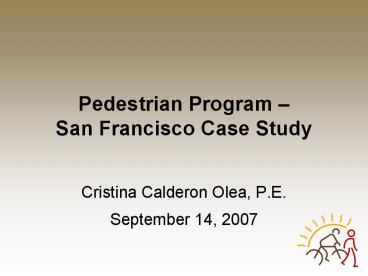Pedestrian Program San Francisco Case Study - PowerPoint PPT Presentation
1 / 29
Title:
Pedestrian Program San Francisco Case Study
Description:
Detects pedestrians still in the crosswalk after flashing don't walk time expires ... The signal begins with a FLASHING YELLOW indication to warn approaching drivers ... – PowerPoint PPT presentation
Number of Views:92
Avg rating:3.0/5.0
Title: Pedestrian Program San Francisco Case Study
1
Pedestrian Program San Francisco Case Study
- Cristina Calderon Olea, P.E.
- September 14, 2007
2
Presentation Overview
- Our Mission
- Pedestrian Safety Tools
- Better Streets Plan
3
San Franciscos Pedestrian Program
- Mission Statement
- To ensure San Francisco remains a walkable City
for all pedestrians, especially children, seniors
and persons with disabilities.
4
San Franciscos Pedestrian Safety Toolkit
5
Pedestrian Countdown Signals
6
Pedestrian Scramble
San Francisco, CA
Sydney, Australia
7
Ped Scramble Considerations
- Useful where there is a high concentration of
pedestrians and turning vehicles - The need to stop vehicles in all directions can
create delay - Lack of obedience to pedestrian signals can be an
issue. Motorist can disobey No Turn On Red. - Diagonal crossings may not be
- feasible at larger intersections.
8
Pedestrian Head Start
- An alternative for conflicts between heavy
turning volumes and moderate to heavy pedestrian
volumes - 2-4 second WALK interval before parallel Green
- Can put pedestrians directly in the path of
travel of turning vehicles
9
Pedestrian Early End
- Dont Walk appears 2 seconds before end of green
- Usually applied along with a turn arrow for
vehicles
10
Accessible Pedestrian Signals
11
Proposed APS Features
- Audible Walk Indication Rapid Tick
- Vibrotactile Walk Indication
- Automatic volume adjustment in response to
ambient sound - Locator Tone
- Tactile Arrow
- Street name in Braille and large print
- Pushbutton Information Message
- Pushbutton actuation tone and light in response
to button push
12
Video Detection for Pedestrians
13
Video Detection for Pedestrians
- Detects pedestrians still in the crosswalk after
flashing dont walk time expires - Extends green and DONT WALK
- Only 1 installation in San Francisco
14
H.A.W.K. Signal
- High-intensity Activated crossWalK
- Used in Tucson, AZ
- A combination of a beacon flasher and traffic
control signaling technique for marked crossings - An extension of the traditional school bus
flashing warning signal when children are
crossing the road and the European level or
emergency crossing signal.
15
H.A.W.K. Signal
16
H.A.W.K Signal - Operations
- Unit is normally off until activated by a
pedestrian - When a pedestrian wishes to cross the street,
they press a button - The signal begins with a FLASHING YELLOW
indication to warn approaching drivers - The FLASHING YELLOW is then followed by a SOLID
YELLOW indication - The signal then changes to a SOLID RED indication
at which time the pedestrian is shown a WALK
indication - The beacon signal then converts to an ALTERNATING
FLASHING RED, allowing the drivers to proceed
when safe, after stopping at the crosswalk
17
San Franciscos Better Streets Plan
- Standards for design and maintenance of the
pedestrian - environment
- Citywide 'cookbook for use by all agencies
18
Why are we doing a Better Streets Plan?
19
Why do we need a Better Streets Plan?
20
Multiple agencies with jurisdiction over streets
Why do we need a Better Streets Plan?
21
Better Streets Plan Goals
Streets that Support Diverse Public Life
22
Streets that are Safe
23
Streets that are Accessible
24
Streets that are Environmentally Friendly
25
Different types of Streets
- Special Streets
- Ceremonial
- Parkway
- Multi-way boulevard
- Small Streets
- Alleys
- Paseos
- Residential
- Neighborhood
- Throughway
- Downtown
- Commercial
- Neighborhood
- Throughway
- Downtown
- Industrial
- Industrial
- Industrial Mixed-Use
26
- Edge Zone
- Accommodate door swings and accessible transit
stops - Furnishings Zone
- Landscaping, furnishings, parking meters, etc.
- Throughway Zone
- 4 minimum clear width
- Frontage Zone
- Shy distance adjacent to building frontage
Sidewalk Zones
27
Basic Improvements
- More consistent trees and plantings
- Pedestrian-scale lighting
- Corner curb extensions at major streets
- Special crosswalk and paving treatments
- Street furnishings
- Reduced street clutter
28
Additional Options
29
Contact
- Cristina Calderon Olea, P.E.
- Manager, Pedestrian Program
- 1 South Van Ness Avenue, 7th Floor
- San Francisco, CA 94103
- Phone 415-701-4579
- Fax 415-701-4343
- Email cristina.olea_at_sfmta.com































